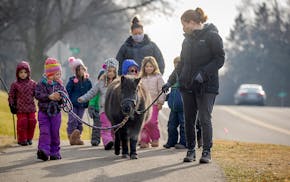When a Minnesotan dies without the means to pay for their funeral, burial or cremation, their county steps in to help.
As required by law, county burial assistance helps memorialize, bury and cremate hundreds of people in Minnesota every year, and in some counties, the need has increased as a result of aging populations, the opioid epidemic and COVID-19.
But like the price of groceries, restaurant meals and other goods and services, the costs surrounding death have risen.
"We're dealing with the manufacturing sector, with caskets. And [the prices for] caskets continue to increase, and vaults continue to increase, and fuel surcharges are put on for delivering those items," said JR Jaskulske, the owner of Oakwood Funeral Home in Maplewood. "I operate a building, and all my costs continue to go up."
In response to rising costs, Ramsey County increased the amount its burial assistance program will kick in. At a meeting last month, the County Board voted to increase its funeral rates to $2,000, and cremation and burial rates to $1,200.
Funeral costs rise
Jaskulske said the rates still won't cover the full cost of providing the services, which he said funeral businesses often take on at a loss.
In Minnesota, the average cost of an affordable burial is $5,900 and basic cremation is $2,955, according to Funeralocity, a consumer advocacy group.
"Embalming is $775 and a basic casket would be somewhere in the area of $1,100," Jaskulske said.
And that's before the cost of a burial vault and cemetery costs are factored in. Funeral businesses aren't required to take these cases, but Jaskulske said many family-owned businesses like his do as a service to their communities.
"I provide county-assisted burials to families that are in my community, in the Maplewood area, and families that I've served," he said. "Sometimes there's just hardships in families and you just have to take care of them."
Bobby Schoenrock, the grounds supervisor at Oakland Cemetery in St. Paul, said Twin Cities cemeteries have seen an increase in county burial assistance cases.
While Schoenrock said county rates often come close to covering cremations, he said burials usually present challenges. Cemeteries typically set aside a portion of burial costs to pay for grave maintenance into the future, he said. Schoenrock said counties' burial assistance rates leave little for future maintenance, which means many cemeteries take on the burial assistance cases when they can, but have to evaluate how many they can afford to handle.
"They want to do what they can for the community, but they also have to do their due diligence," he said.
How it works
When a Ramsey County resident dies without money to cover the costs associated with death, applications for help go to Ramsey County's Financial Assistance Services department.
There, Jojean Ziegler, the financial assistance supervisor, and other staff members review the person's income and assets, including life insurance and money in bank accounts. In the case of married couples or a minor, the county also looks at family members' assets. Funeral businesses can also ask families to contribute a sum of money, capped at $830 for funerals and cremations, and $1,300 for cemeteries.
Ziegler said the rate increase comes as she's heard from businesses that their costs are rising. The county last increased its rates in 2016.
In recent years, the number of Ramsey County burial assistance cases has gone up and down. Last year, there were 522 approved, at a cost of $616,000. So far this year, there have been more than 420, costing more than $508,000.
Some counties see increase
Other counties are bracing for an increase in county assistance cases.
Years ago, Hennepin County raised its burial assistance to $3,000, with up to $2,000 in additional family contributions permitted for enhanced services, spokesperson Carolyn Marinan said. "Suffice it to say we are definitely seeing an increase [in requests for burial assistance]," she wrote in an email, citing the opioid epidemic and COVID as factors driving an increase in demand in recent years.
However, the number of people dying of opioid overdoses has declined recently, partly attributed to more widespread availability of overdose-reversal drug naloxone.
Carver County, which will cover up to $2,550 for cremations and $3,600 for burials, is expecting an increase in county assistance cases as the county projects its largest population growth in the number of people 65 years old and older, spokesperson Ari Lyksett said in an email.
Scott County covers up to $5,000 of eligible costs regardless of how applicants are put to rest, and has seen an overall increase in applications and spending, Kari Ouimette, Scott County health and human service economic assistance director, wrote in an email.
In Ramsey County, Ziegler said the program is an important one that Minnesotans should be aware of.
"I think people just need to know that it's available," she said. "I think a lot of families don't and then they struggle to pay to have their loved one put to rest."
Supreme Court allows DOGE team to access Social Security systems with data on millions of Americans

Thompson found guilty of murder in car crash that killed 5 young women

University of Minnesota is putting its golf course up for sale
Feeding Our Future probe: Apple Valley woman charged with defrauding food program of $1.4 million

